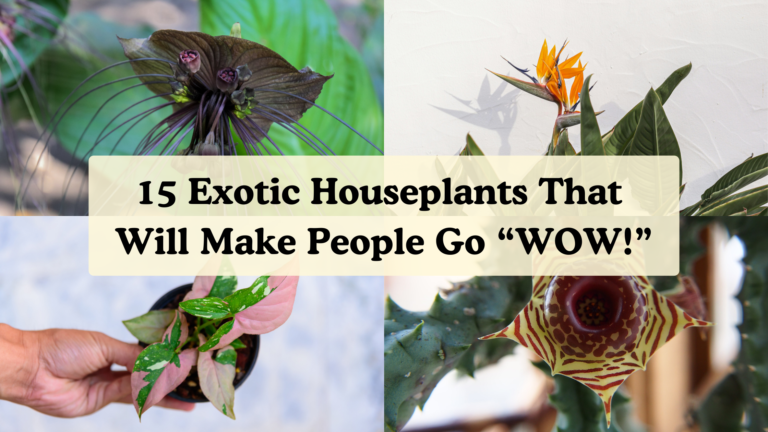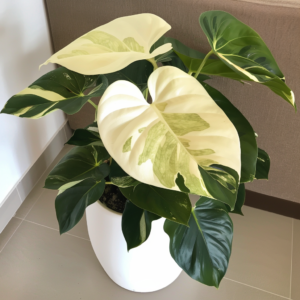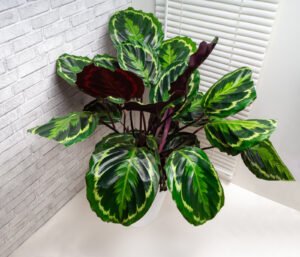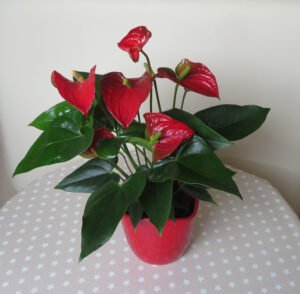As a plant lover, I’ve always fancied adding rare houseplants to my indoor plant collection that make people stop and say “WOW!” If you desire the same for your space, let me introduce you to the 15 most exotic and unusual houseplants that will upgrade indoor gardens like no other!
1. Strelitzia/Bird of Paradise
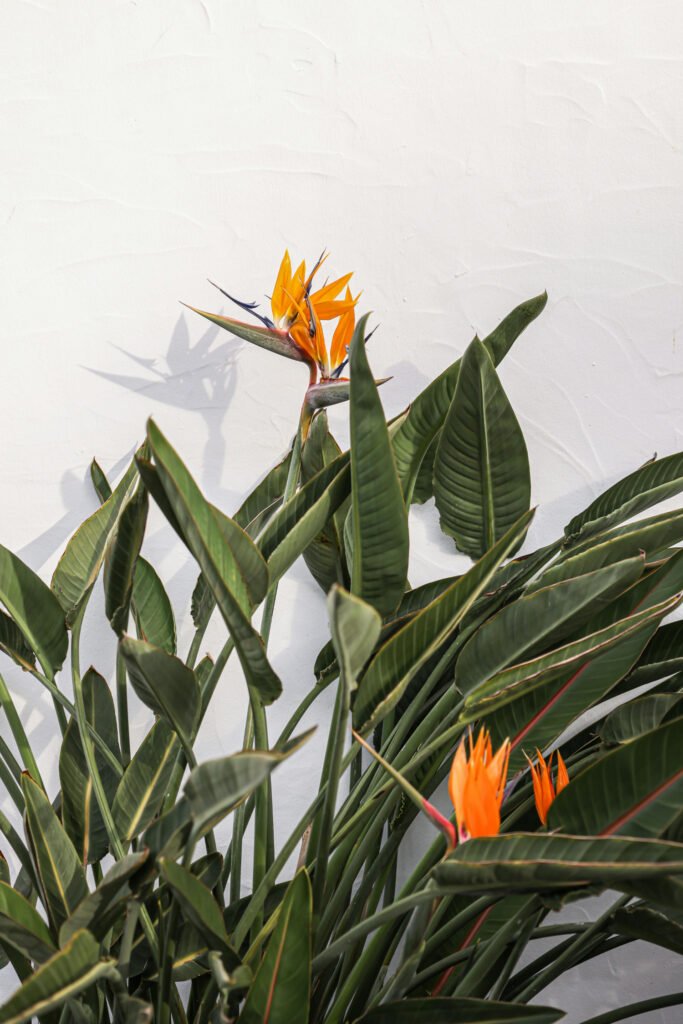
- Botanical Name: Strelitzia nicolai
- Plant Type: Herbaceous
- Flowers: Bird-shaped flowers in yellow, orange-blue & white
- Height: Up to 6 feet
- Light: Indirect Sunlight
- Water: Every 7-8 days (as the topsoil dries)
Let’s start with the majestic Strelitzia, also known as the Bird of Paradise. This South African native is a showstopper with its large, oval, banana-like leaves and unique bird-shaped flowers in vibrant orange and blue hues.
This unusual plant can grow up to an impressive 6 feet tall, with flowers reaching 7 inches in length. Besides, Strelitzia thrives in bright, indirect light and well-draining soil, and moderate humidity.
Interestingly, in its native habitat, the flowers are pollinated by sunbirds. It also comes with a blue and white flower variety named, Strelitzia nicolai!
Fun Fact: This evergreen tropical plant was named after Charlotte of Mecklenburg-Strelitz, Queen consort and wife of King George III.
2. Black Bat Flower
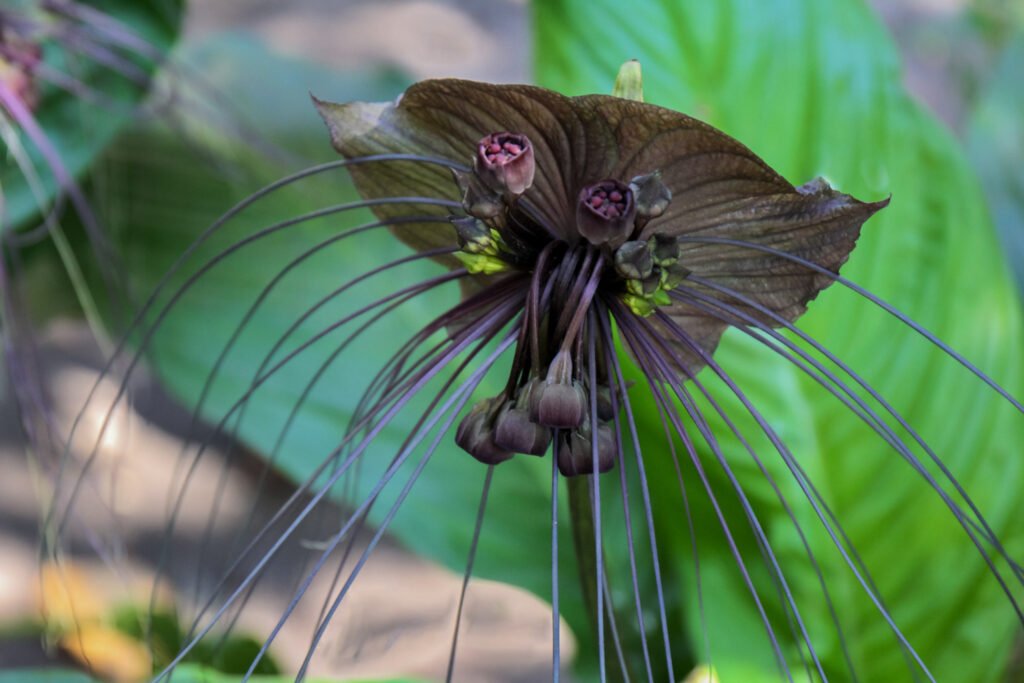
- Botanical Name: Tacca chantrieri
- Plant Type: Perennial
- Flowers: Dark purple (almost black) bat-like flowers with long bracteoles
- Height: Up to 3 feet tall
- Light: Indirect Sunlight
- Water: Every 7-8 days (as the topsoil dries)
The Black Bat Flower, also known as Devil Flower or Bat Plant, is another conversation piece with its unusual, dark purple, almost black flowers resembling the face of a bat. Originating from Southeast Asia, this plant comes in varieties like Black, Green, and White Bat Flowers.
The flowers, which can reach up to 12 inches in length, are accompanied by long, whisker-like filaments/bracteoles, giving it other names like Tiger Beard or Cat’s Whiskers.
The flowers emit a scent that attracts flies for pollination. This houseplant prefers partial shade, well-draining soil, and high humidity.
3. Philodendron Pink Princess
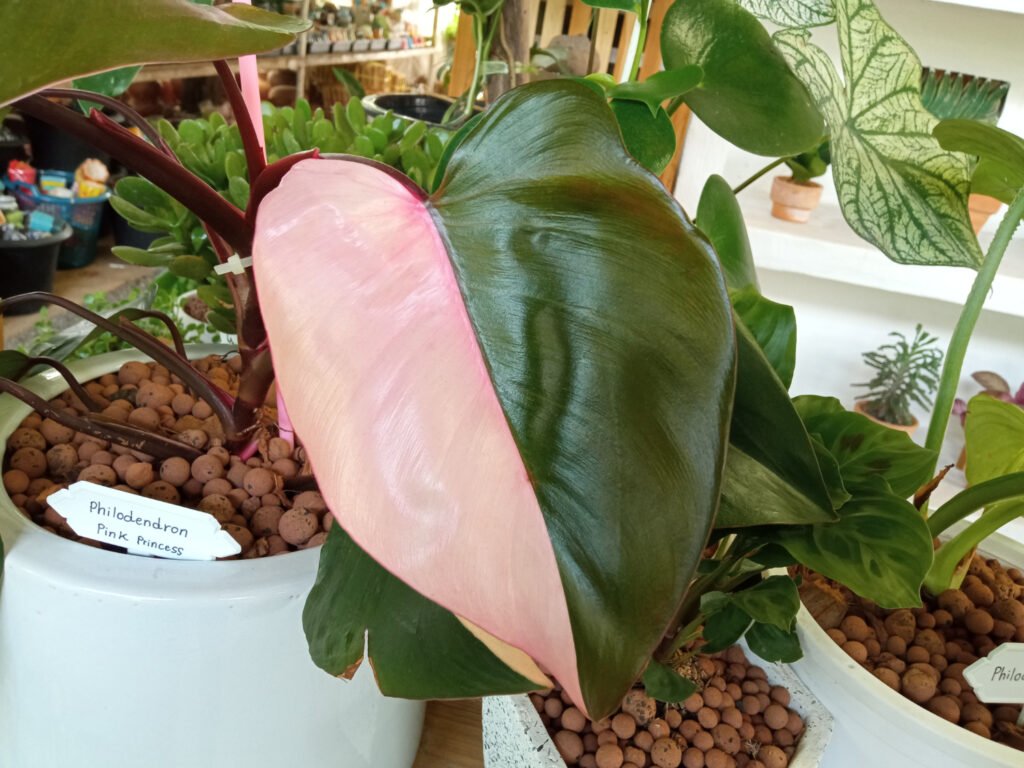
- Botanical Name: Philodendron erubescens
- Plant Type: Angiosperms (vine)
- Flowers: Small white & green flowers
- Height: Up to 4 -5 feet
- Light: Bright indirect light
- Water: Every 1 to 2 week, when the soil is mostly dry
If you’re a fan of colorful foliage, the Philodendron Pink Princess is a sought-after and rare houseplant that will brighten up your space. This trailing or climbing plant has dark green leaves adorned with pink variegation, earning it the nickname Blushing Philodendron.
The pink variegation is caused by a genetic mutation and varies in each plant, making each plant and each leaf a unique work of art. These leaves can grow up to 8 inches long, while the vines can reach 3-4 feet in length. If pink is not your color, you can get a White Princess Philodendron!
4. Aglaonema Red Slam (Chinese Evergreen)
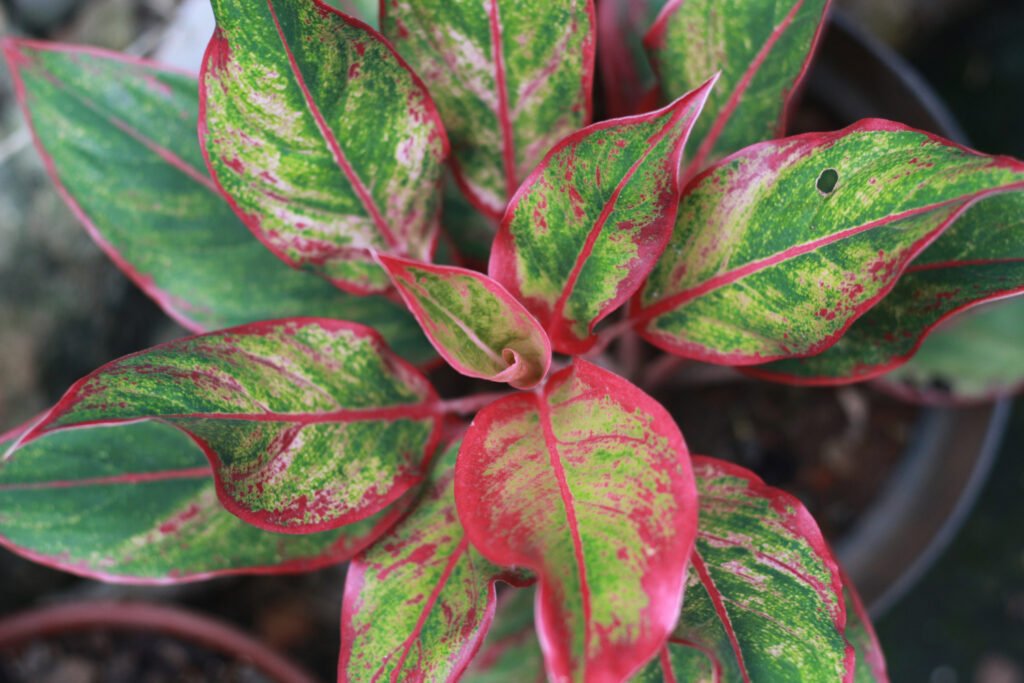
- Botanical Name: Aglaonema commutatum
- Plant Type: Herbaceous Perennial
- Flowers: Green & white
- Height: Up to 3 feet tall
- Light: Bright indirect light
- Water: Every 1 to 2 weeks, when the soil is mostly dry
Aglaonema Red Slam, also known as Chinese Evergreen, is a low-maintenance starter plant that features lush, glossy, ovate dark green leaves with bright red or pink variegation. In low to moderate light and moderate humidity, it can grow up to 3 feet tall and wide.
Native to tropical regions of Asia, the Aglaonema Red Slam is not only beautiful but also practical! That’s right! This plant is known for its air-purifying qualities, removing toxins like benzene and formaldehyde from the air.
Its other popular varieties include Aglaonema Siam Aurora and Aglaonema Creta. Some varieties are believed to bring good luck and fortune.
5. Tricolor Arrowhead Plant
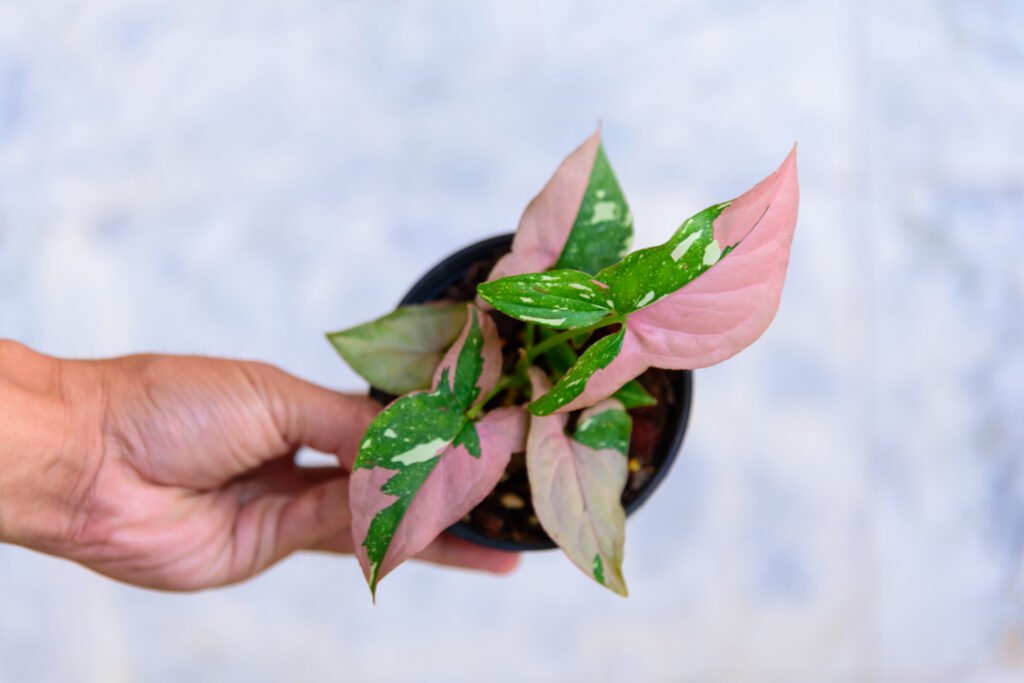
- Botanical Name: Syngonium podophyllum
- Plant Type: Aroid, Climbing vine
- Height: 3 – 6 feet tall
- Light: Medium Sunlight (No Direct Sun)
- Water: When topsoil is dry
Tricolor Arrowhead is a small bushy plant with arrowhead-shaped leaves featuring variegation in shades of green, pink, and white. Originating from South America, this trailing or climbing plant can grow up to 6 feet long, with leaves reaching up to 6 inches in length.
Interestingly, as the plant matures, the leaves might change shape, starting as simple arrowheads and developing into more complex, lobed shapes. Generally, this plant prefers temperatures over 60°F.
6. Red Butterfly Wing Plant
- Botanical Name: Christia vespertilionis
- Plant Type: Fabaceae (Leguminosae)
- Flowers: White flowers
- Height: Up to 2 feet tall
- Light: Diffused or Shade sunlight
- Water: Every 7-8 days
Red Butterfly Wing Plant features vibrant red, wing-shaped bracts surrounding small, white flowers, giving the appearance of fluttering butterflies, hence, getting the nickname.
This compact plant can grow up to 2 feet tall, with bracts reaching up to 4 inches wide. Interestingly, the bracts are often mistaken for flowers, but they are actually modified leaves.
A native to the tropical regions of Central and South America, It thrives in indirect light, well-draining soil, and moderate humidity.
7. Twisted Cactus
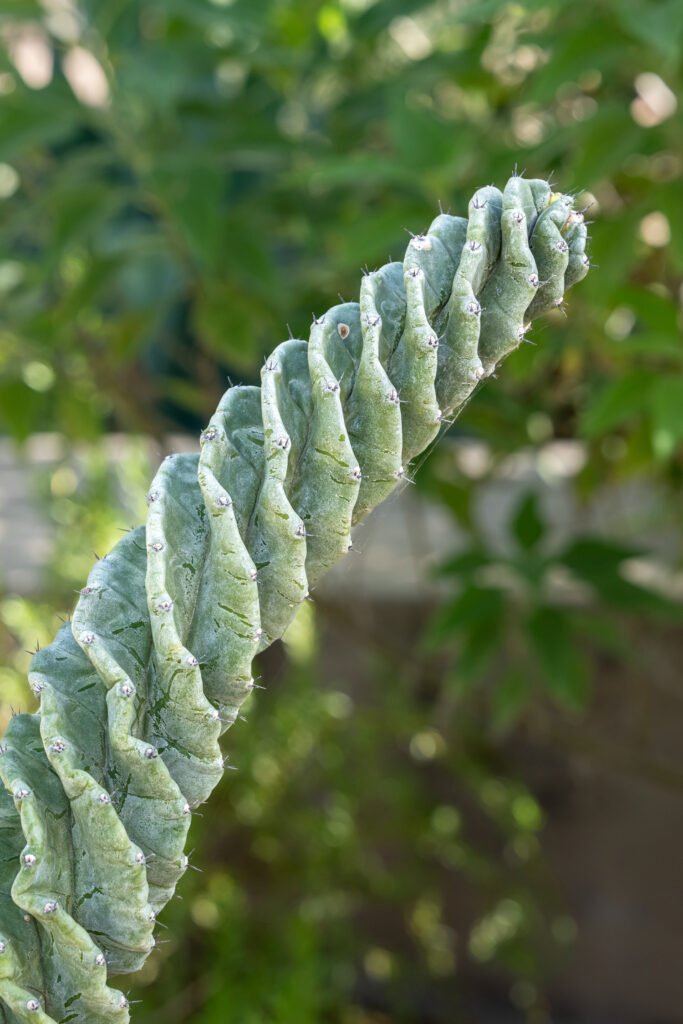
- Botanical Name: Cereus Forbesii Spiralis
- Plant Type: Cactaceae
- Flowers/Fruits: White/Pink and Large purple fruits
- Height: 3-4 feet tall
- Light: Bright, direct light
- Water: Every 10-12 days
Twisted Cactus is a succulent cactus native to arid regions of Mexico and Central America that will add a unique architectural element to any plant collection. It features cylindrical, green stems with prominent ridges that twist and spiral as the plant grows, with rows of hair-like spines.
The twisting of the stems is caused by a genetic mutation, creating a mesmerizing sculptural effect. Besides, the plant might revert to a straight growth pattern if propagated from cuttings. Often called the Totem Pole Cactus, this Mexican native can grow up to 4 feet tall!
8. Lifesaver Plant
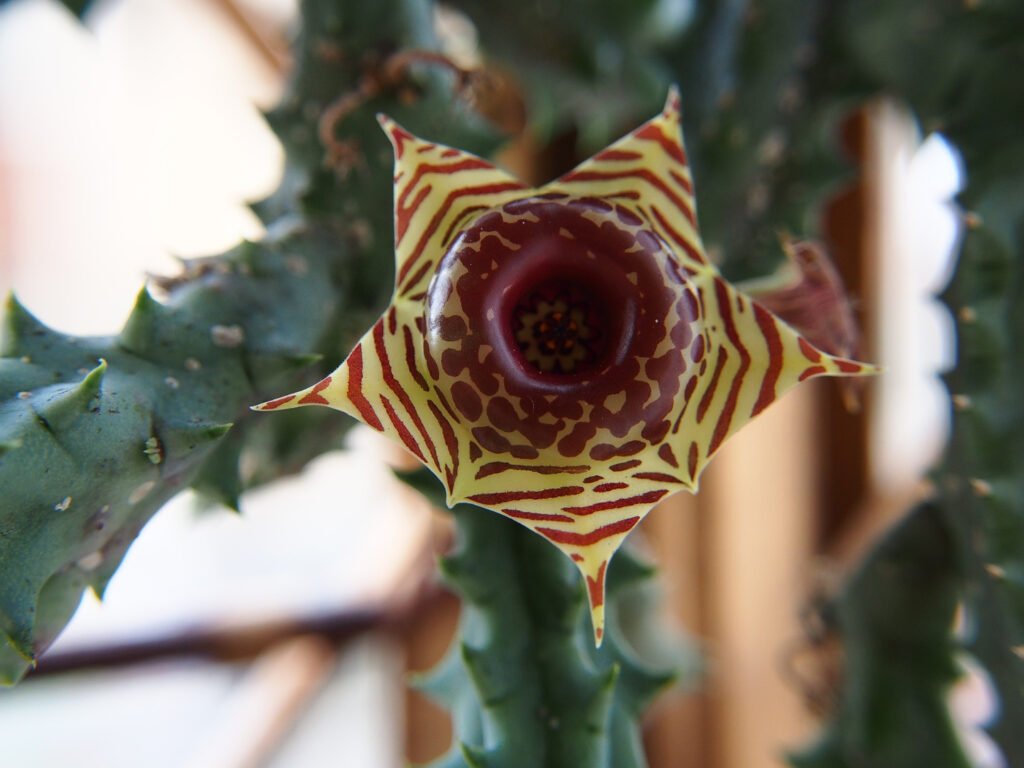
- Botanical Name: Huernia zebrina
- Plant Type: Succulent
- Flowers: A star-shaped flowers with a unique, lifesaver candy-like appearance
- Height: Up to 6 inches tall
- Light: Prefers bright, indirect light but can tolerate some direct sunlight
- Water: Every 9-10 days
The Lifesaver Plant, also known as Huernia Zebrina, is a small, succulent plant native to arid regions of South Africa. It features fleshy, green stems and unusual, star-shaped flowers with a striped, red and yellow pattern resembling a lifesaver candy.
These stripes give the plant its nicknames, Zebra Plant and Carrion Flower. Interestingly, the flowers emit a strong, unpleasant odor to attract flies for pollination.
Generally, the Lifesaver Plant thrives in low humidity and temperatures between 60-80°F, making it an easy-to-care option for your exotic plant collection!
9. Monstera Deliciosa
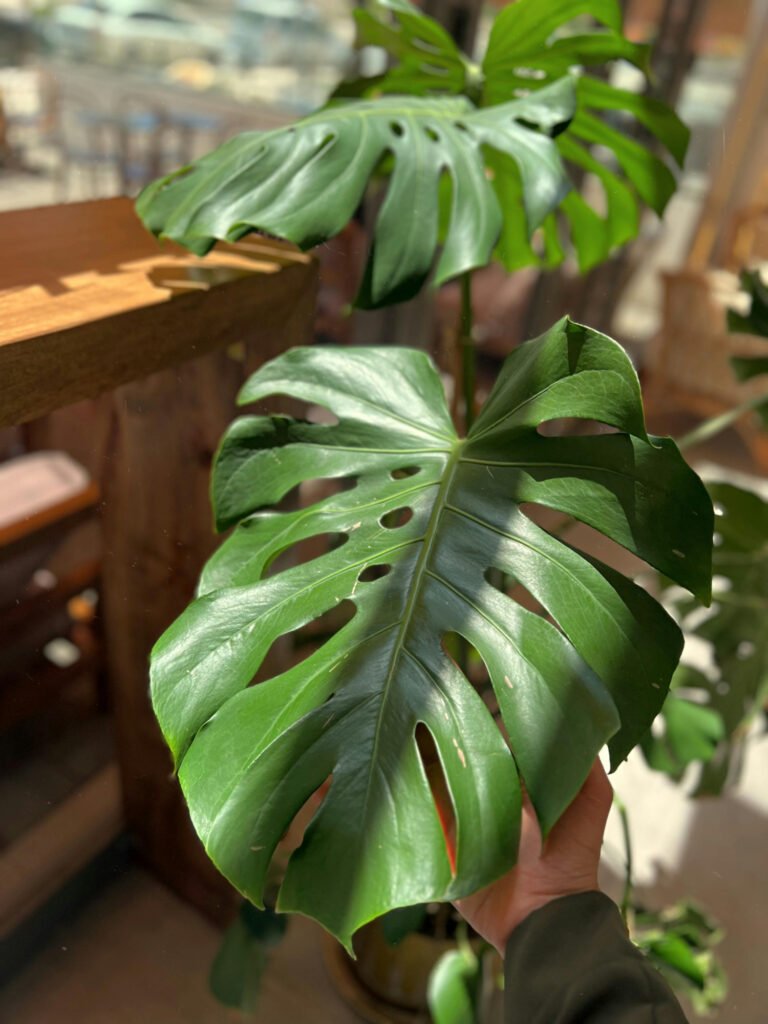
- Botanical Name: Monstera deliciosa Liebm
- Plant Type: Perennial vine (liana epiphyte)
- Flowers/Fruits: A large corn-like erect spadix surrounded by a thick spathe
- Height: 10 to 15 feet tall
- Light: Indirect bright light
- Water: Every 1-2 weeks depending on the environment
This list of exotic and rare house plants would be complete without mentioning the Monstera Deliciosa, also known as the Swiss Cheese Plant! This unique Perennial plant is beloved for its large, glossy, heart-shaped leaves with distinctive holes and splits.
These holes in the leaves, known as fenestrations, help the plant withstand strong winds in its natural habitat. But don’t worry if your Monstera only has a few holes in the beginning – as the plant matures, the leaf holes will grow.
In many cases, they grow towards the edge and open up, resulting in the iconic split-leaf appearance, earning another nickname, split-leaf philodendron. This indoor plant can reach the height of 10 to 15 feet tall when grown indoors.
To keep your Monstera happy, provide it with bright, indirect light and slightly moist soil. Monstell Thai Constellation and Monstero Albo are other varieties worth checking out!
Fun Fact: In its native habitat, Monstera Delicosa may produce edible fruit that tastes (and looks) like a combination of pineapple and banana!
10. Zebra Plant
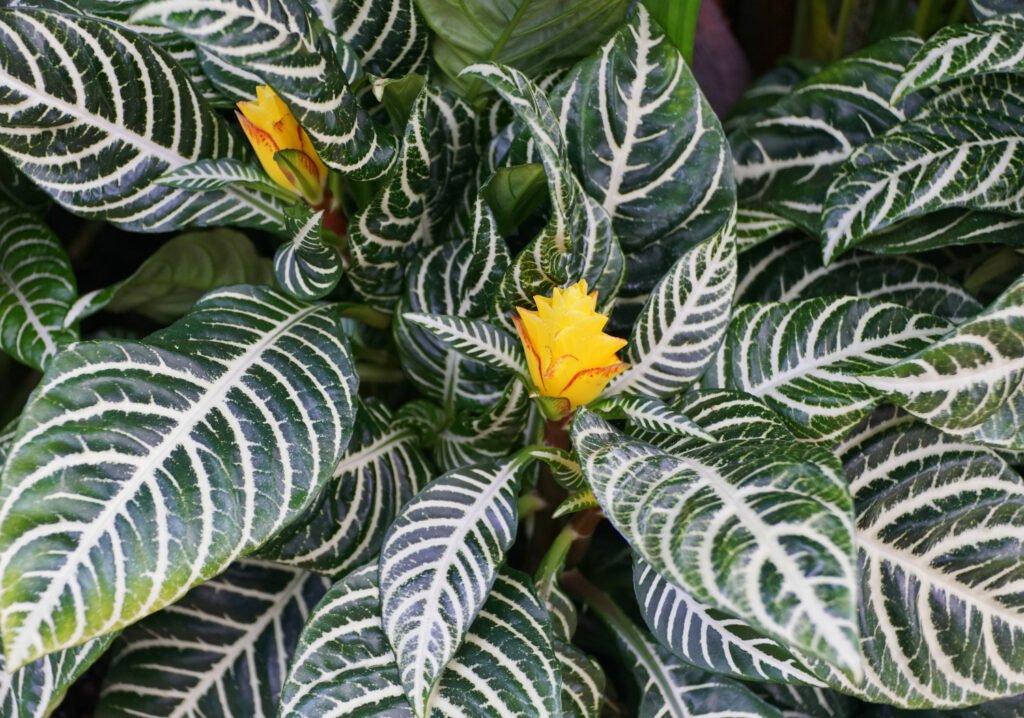
- Botanical Name: Alocasia zebrina
- Plant Type: Perennial, bulb
- Flowers: Small green & white flowers
- Height: Up to 6 feet tall
- Light: Medium to bright, Indirect sunlight
- Water: Every week
If you love bold, striking patterns, the Zebra Plant (Calathea zebrina) is a must-have! With its dark green, oval leaves featuring prominent white veins, this Brazilian native looks stellar! It’s believed that the white stripes on the leaves are an adaptation that helps reflect sunlight in its native habitat.
Besides, thanks to its tropical nature, it can easily thrive in low to moderate, indirect light and high humidity, growing up to 6 inches tall and 12 inches wide. This also makes this plant an ideal choice for bathrooms or kitchens.
The leaves of this fast-grower perennial plant fold up at night, earning it the nickname “Prayer Plant.”
11. Jewel Orchid
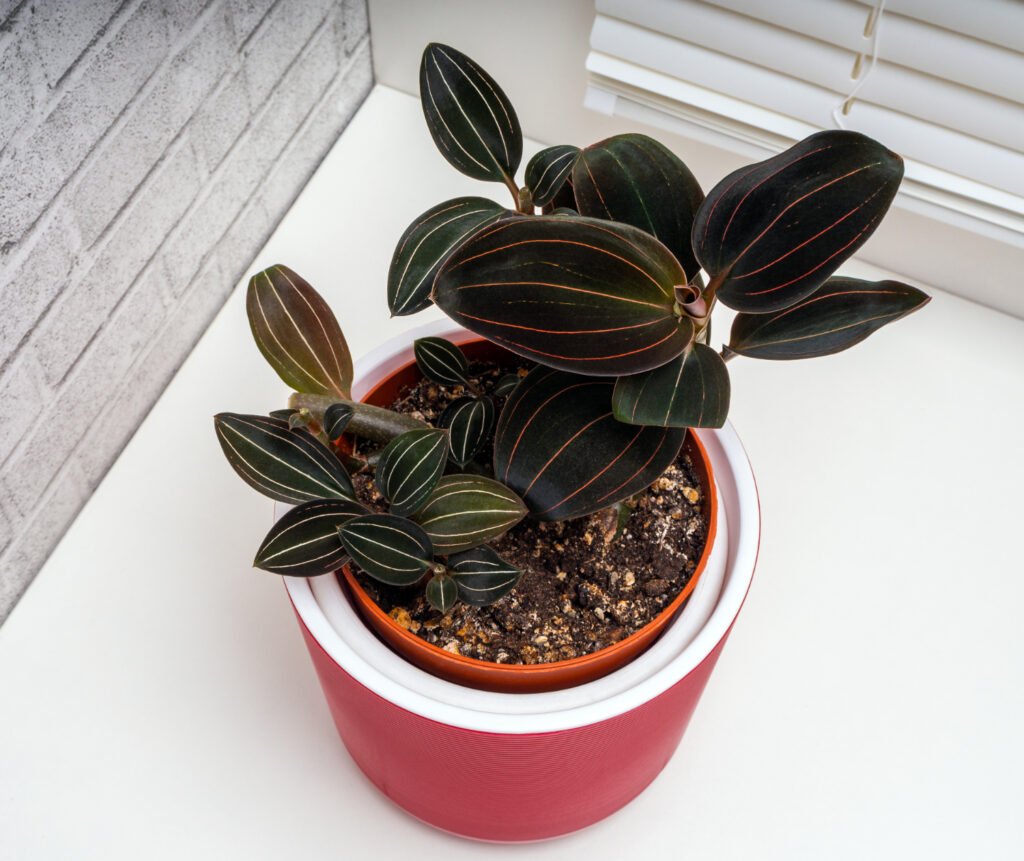
- Botanical Name: Ludisia discolor
- Plant Type: A type of orchid
- Flowers: Small white flowers
- Height: 6 to 12 inches
- Light: Bright, indirect sunlight
- Water: Every 7-9 days
The Jewel Orchid is a small but incredibly beautiful plant with intricate, colorful leaf patterns. Native to tropical regions of Southeast Asia, this plant features small, lance-shaped leaves in shades of green, red, purple, or silver, with contrasting veins.
These intricate vein patterns on the leaves help the plant absorb more light in shaded environments. When grown in medium light and high humidity, Jewel Orchid can grow up to 12 inches tall and wide. While it does produce small, white flowers, the plant’s actually known for its stunning foliage!
12. Polka Dot Begonia
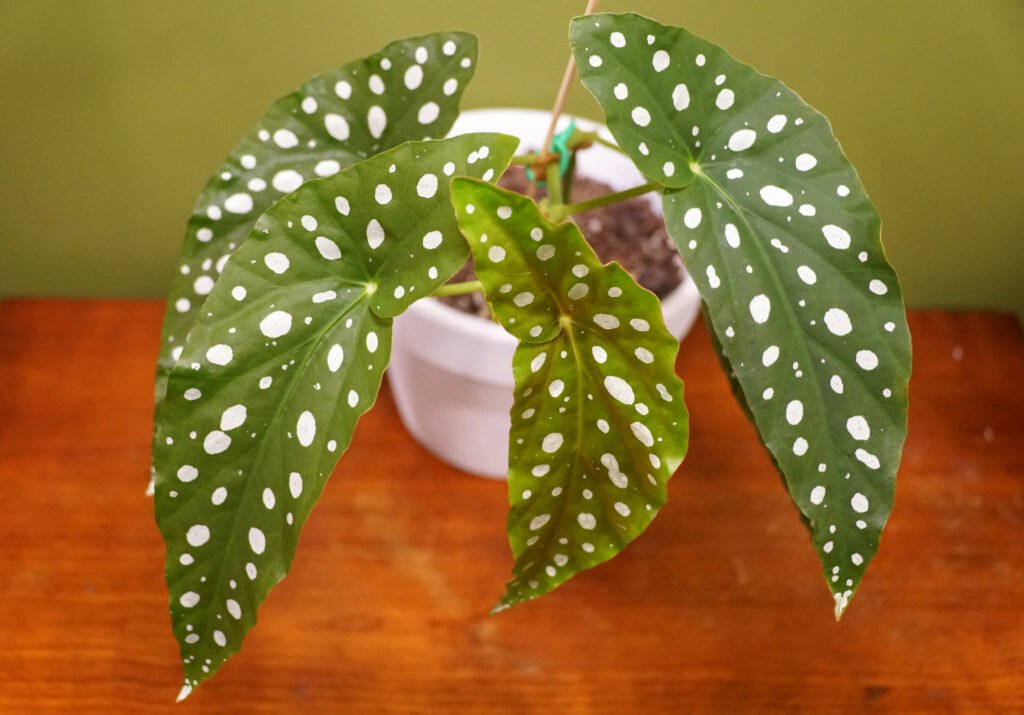
- Botanical Name: Begonia Maculata
- Plant Type: Perennial
- Flowers: White to Light Pink flowers
- Height: Up to 5 feet tall
- Light: Limited or partial bright light
- Water: Twice a week (When the topsoil feels dry)
As the name states, Polka Dot Begonia is an eye-catching plant with small, round leaves adorned with white or pink spots or Polka dots! The uneven spots on the leaves result from a lack of chlorophyll.
Its unique patterned foliage gives the plant its nickname, Spotted Begonia or Begonia Maculata. It may also bear small and delicate flowers in shades of pink or white.
This bushy plant is native to tropical regions of Southeast Asia and can grow up to 5 feet tall, with leaves reaching up to 2 inches in diameter. It may also bear small and delicate flowers in shades of pink or white.
13. Song of India
- Botanical Name: Dracaena reflexa
- Plant Type: Shrub
- Flowers: White clustered flowers
- Height: Up to 6 feet tall
- Light: Bright, indirect light
- Water: Once a week (when the soil is dry)
Dracaena Reflexa is a slender, upright plant native to tropical regions of Madagascar and other Indian Ocean islands. It features narrow, lance-shaped leaves with yellow or white stripes. This gorgeous plant is also known as the Song of India, Song of Jamaica, or Pleomele.
It is also an air-purifier plant as it helps to remove toxins like formaldehyde and xylene from the air, making it a perfect houseplant choice. Dracaena Reflexa prefers bright, indirect light, well-draining, slightly moist soil, moderate humidity, and temperatures between 60-80°F.
When grown indoors in slightly moist soil and bright, indirect light and a temperature between 60-80°F, Dracaena Reflexa generally reaches up to 6 feet. But, surprisingly, one of my Dracaena grew about 15 feet tall!
14. Coleus Purple Plant
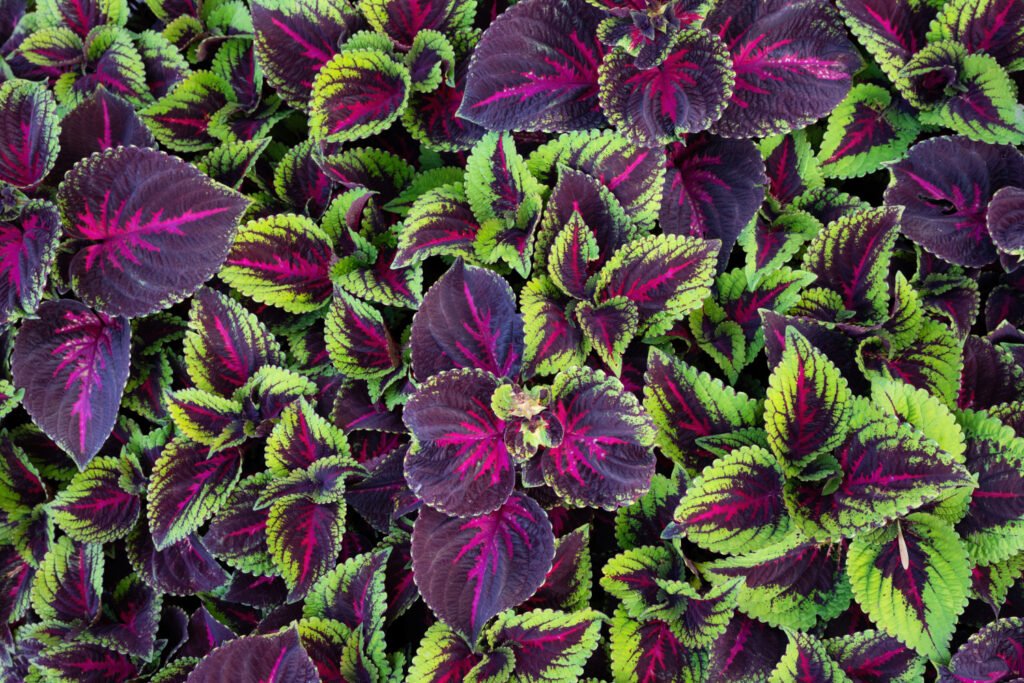
- Botanical Name: Coleus scutellarioides
- Plant Type: Lamiaceae (mint family)
- Flowers/Fruits: Tiny flowers
- Height: Up to 3 feet
- Light: Bright, indirect light
- Water: Once a week (when the topsoil feels dry)
Coleus Purple Plant is known for its brightly colored, serrated leaves in shades of purple, pink, red, and green that are lightly fuzzy to the touch, giving them an almost iridescent appearance. The vibrant colors of the leaves come from a pigment called anthocyanin in them.
This gorgeous plant is also popular as the Velvet Plant or Painted Nettle. Native to Southeast Asia, Coleus can grow up to 3 feet tall in a warm and well-light environment. You would also love its Coleus blumei and Coleus scutellarioides varieties.
15. Anthurium

- Botanical Name: Anthurium andraeanum
- Plant Type: Araceae
- Flowers/Fruits: Red, orange, pink, and purple flowers
- Height: Up to 2 -3 feet tall
- Light: Bright, indirect light
- Water: Every nine days (when the topsoil is dry)
Another exotic plant that’s sure to turn heads is the Anthurium, also known as the Flamingo Flower or Tailflower. It has glossy, heart-shaped leaves and unique, waxy flowers consisting of a colorful spathe and a protruding spadix.
The spadix can be red, pink, orange, purple, and even white, depending on the plant variety! Anthurium is native to tropical regions of Central and South America and, hence, prefers bright, indirect light and slightly moist soil.
In favorable indoor conditions, it can grow up to two to three feet tall. Check out more Anthurium plant care tips now!
Try This: If your Anthurium foliage is fading, provide it with more light.
If you want to add a magical touch to your plant collection, these 15 exotic house plants are the best picks to go for! Some of these look so unique that they almost look artificial! So, go on and pick a plant that will add a unique, regal touch to your little indoor garden!

